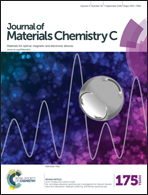Layered-material WS2/topological insulator Bi2Te3 heterostructure photodetector with ultrahigh responsivity in the range from 370 to 1550 nm†
Abstract
Transition metal dichalcogenides (TMDs) manifest excellent phonon-limited mobility and strong light–matter interaction, which, however, conflict with the long response time and low responsivity of TMD-based photodetectors. The extreme susceptibility of TMDs' electronic qualities to the large density of unscreened disturbances from the SiO2 substrate accounts for such inconformity. Here, we evaluated the potential of WS2 for photodetectors by passivating SiO2 substrates with layered Bi2Te3, a representative three dimensional topological insulator. Comparative photoswitching measurements of the WS2/Bi2Te3 photodetector demonstrated its stable and broadband photoresponse from 370 to 1550 nm. Meanwhile, WS2 and Bi2Te3 allied a high responsivity of 30.7 A W−1, a pronounced detectivity of 2.3 × 1011 cm Hz1/2 W−1 as well as a short response time of 20 ms, which make the device stand out among previously reported WS2 photodetectors. In fact, the responsivity and detectivity are comparable to those of state-of-the-art commercial Si and Ge photodetectors (R ∼ 0.5 to 0.85 A W−1, D* ∼ 3 × 1011 to 3 × 1012 cm Hz1/2 W−1), suggesting its great potential for practical applications. In addition, we also established that the excellent device performance is attributed to the synergy of the passivation of the SiO2 substrate, efficient carrier separation at the WS2/Bi2Te3 heterointerface and excellent carrier transport along the time-reversal-symmetry protected surface channel of Bi2Te3. In summary, these findings suggest that the WS2/Bi2Te3 photodetector will launch a significant advance in next-generation photodetection. Moreover, the interface engineering strategy depicts a universal scenario for development of TMD devices in the future.


 Please wait while we load your content...
Please wait while we load your content...